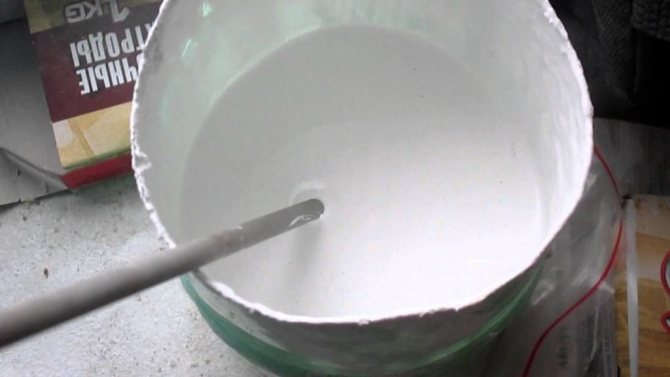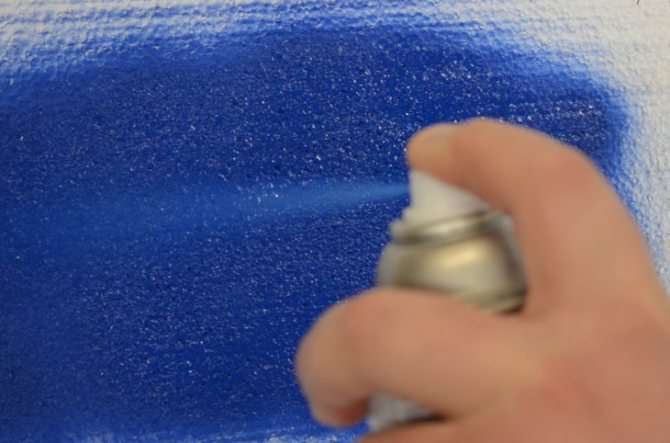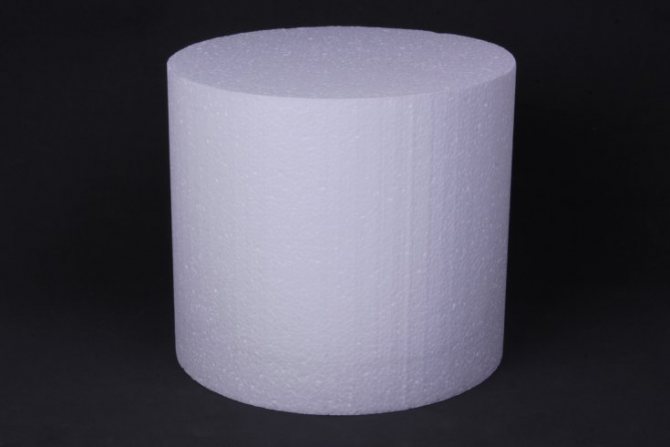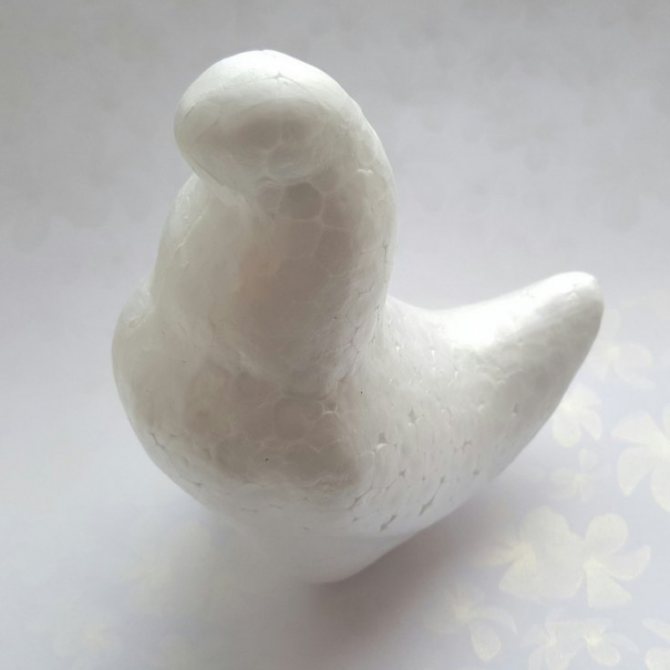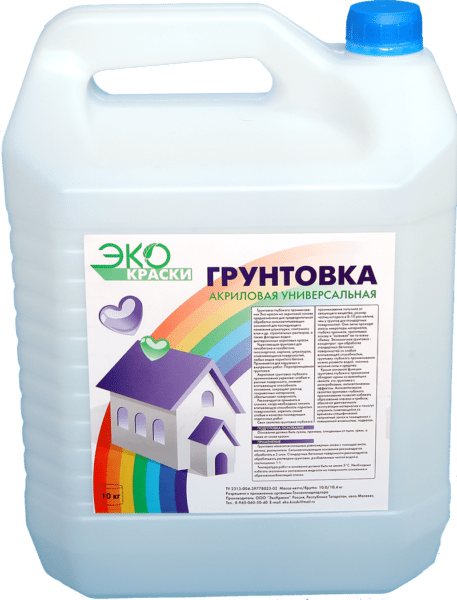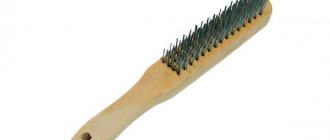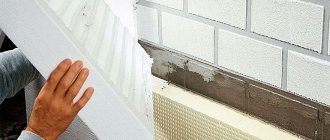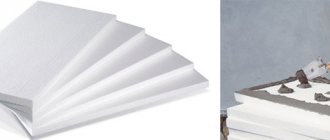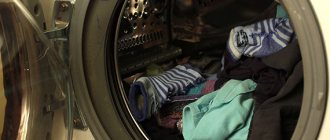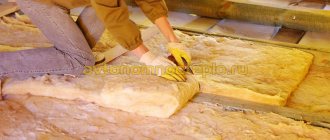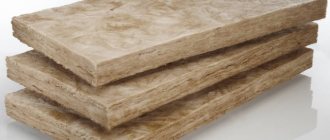How to paint interior foam surfaces?
It is better to treat elements of interior decoration made of polystyrene with water-based paint. It can be a baguette, tile, foam baseboard. High quality paint does not create streaks and drops. It lays down evenly on the product and closes the pores. Tikkurila Harmony, Sniezka Eco, Caparol Unilatex deserve positive reviews here.
1. Before painting, the surface is thoroughly cleaned of dust with a dry cloth. You need to paint in one direction, avoiding the formation of streaks. The coating can be multi-layer
It is important to consider that before applying each subsequent layer, the surface must be completely dry.
2. If you need to paint the foam ceiling panels, you should take into account some technological features. It will be useful to cover the furniture with polyethylene, use special glasses and work clothes. The tiles, as a rule, have a relief pattern. It is unlikely that you can make an even coating with a roller and a brush. Therefore, it is better to use a spray gun. And before that, all joints are putty or use a sealant. The entire required volume of paint, the desired shade, is pre-procured. The desired color is obtained using a color scheme that can be selected in hardware stores.

3. When the styrofoam ceiling plinth is painted, it is easy to stain the wallpaper (if it is already glued). To avoid this, thin brushes are the obvious solution.
4. You can apply decorative elements using gouache. The product painted with "water emulsion" is painted with an ornament, if desired. Drawn with a pencil first. And then gouache and brushes are applied. Such a move will add originality to the interior.
Painting slabs outside the building
Expanded polystyrene is often used for cladding the external walls of a structure. Therefore, having figured out the question of what paint can be used to paint the foam inside the building, you should decide on the materials used to decorate the facade. In this situation, it is preferable to choose an acrylic suspension. Moreover, it is better to purchase aerosols that do not contain freon. They dry instantly and create a waterproof film on the foam surface.
Although the choice of paints for outdoor use is extensive, most of them include aggressive components that destroy polystyrene foam. Therefore, before the foam plates covering the facade of the house are painted, a protective layer is imposed on them without fail. Most often, “liquid glass” is chosen for these purposes. It is pre-diluted with a primer, achieving the most uniform consistency. Another option for protecting the foam is the application of a liquid putty.
After drying, the facade can be painted with the selected acid-containing composition. The brush should be worked in one direction. It is recommended to apply at least two layers of paint, be sure to take a break before applying each subsequent one. Products such as Novasil Tikkurila, Terraco Maxishield, Düfa Fassedenfarbe 90, acrylic aerosols from Bosny and Pozitiv work well here.
How to paint polystyrene - The best facades of private houses
Exterior and interior decoration of buildings with polystyrene foam (expanded polystyrene) is becoming more and more popular. However, the white color of the material does not always fit into the design. Therefore, the builder is faced with the question of how paint styrofoamconsidering its specific properties and structure? This article will help you understand the nuances of the process.
When choosing a paint, you should pay attention to:
one.its properties (good adhesion, moisture resistance, high density and chemical resistance)
2. the absence of a solvent in the composition, since otherwise the latter will simply corrode the foam;
3. the location of the coloring material (inside or outside).
Water-based paint is perfect for expanded polystyrene. Its advantages include:
It is easy to apply and has a low cost, but has a low degree of water and dirt resistance. A more practical alternative would be to paint the styrofoam with acrylic.
Possessing the advantages of the previous version, this coating is also elastic, resistant to moisture, dust and temperature fluctuations, and dries quickly. But it is short-lived. Silicone mixtures are the leader among solutions. They are devoid of the disadvantages of the aforementioned paints.
They can be chosen to paint the facade. At the same time, such a composition is perfect for interior work, especially in rooms with high humidity.
How to paint styrofoam on interior surfaces?
It is better to treat elements of interior decoration made of polystyrene with water-based paint. It can be a baguette, tile, foam baseboard. High quality paint does not create streaks and drops. It lays down evenly on the product and closes the pores. Tikkurila Harmony, Sniezka Eco, Caparol Unilatex deserve positive reviews here.
1. Before painting, the surface is thoroughly cleaned of dust with a dry cloth. You need to paint in one direction, avoiding the formation of streaks. The coating can be multi-layered. It is important to consider that before applying each subsequent layer, the surface must be completely dry.
2. If you need to paint the foam ceiling panels, you should take into account some technological features. It will be useful to cover the furniture with polyethylene, use special glasses and work clothes. The tiles, as a rule, have a relief pattern.
It is unlikely that you can make an even coating with a roller and a brush. Therefore, it is better to use a spray gun. And before that, all joints are putty or use a sealant. The entire required volume of paint, the desired shade, is pre-procured.
The desired color is obtained using a color scheme that can be selected in hardware stores.
3. When the styrofoam ceiling plinth is painted, it is easy to stain the wallpaper (if it is already glued). To avoid this, thin brushes are the obvious solution.
4. You can apply decorative elements using gouache. Products painted with "water emulsion" are painted with an ornament, if desired. Drawn with a pencil first. And then they use gouache and brushes. Such a move will add originality to the interior.
How to paint polystyrene outside the building
Expanded polystyrene is often used for cladding the exterior walls of a building.
Therefore, having figured out the question of what paint can be used to paint the foam inside the building, you should decide on the materials used to decorate the facade. In this situation, it is better to choose an acrylic slurry.
Moreover, it is better to purchase aerosols that do not contain freon. They dry instantly and create a waterproof film on the foam surface.
Although the choice of paints for outdoor use is large, most of them contain aggressive components that destroy polystyrene foam.
Therefore, before painting the foam plates that lined the facade of the house, a protective layer is imposed on them without fail. Most often, “liquid glass” is chosen for these purposes.
It is pre-diluted with a primer, achieving the most uniform consistency. Another option for protecting the foam is to apply a liquid putty.
After drying, the facade can be painted with the selected acid-containing composition. The brush should be worked in one direction.It is recommended to apply at least two layers of paint, be sure to take a break before applying each subsequent one. Products such as Novasil Tikkurila, Terraco Maxishield, Düfa Fassedenfarbe 90, acrylic aerosols from Bosny and Pozitiv work well here.
Is it difficult to paint polystyrene foam? Given the nuances described in this article, the reader will handle this process. It is necessary to paint the facade of the house or the ceiling made of foam - the result will definitely please.
How to paint Styrofoam - Easy and Simple The white color of the material does not always fit into the design. Therefore, the builder is faced with the question of how to paint the foam, given its specific properties?
Source: www.mislife.ru
Decorating the house with styrofoam has long been part of our everyday life. People began to massively insulate their homes with expanded polystyrene, both outside and inside.
In addition to insulation, indoor foam is often used in the form of decorative and artistic elements (baguettes, various imitation stucco moldings, artistic decor, plinths, etc.). But in order for the finish to get a complete look, all decor elements need to be given the appropriate color, roughly speaking, painted.
And how to paint the styrofoam? This material has a very characteristic structure, from which it follows that not every paint will work, and the painting technology is different.
How to choose a foam paint?
First you need to note that not every foam surface can be painted. Not worth it, trying to paint a plastic laminated ceiling tile, this is for example.
Source: https://luchiefasady.ru/chem-pokrasit-penoplast.html
Decorative items for the interior
DIY styrofoam crafts can serve as a decor and add zest to the interior.
Imitation brick on the wall
A brick wall is a fashionable way to visually change the space in a room and add originality to a home environment. For this, various panels are sold, both from solid materials and foam, and simple wallpapers with a suitable print. It will be cheaper to make your own foam bricks.
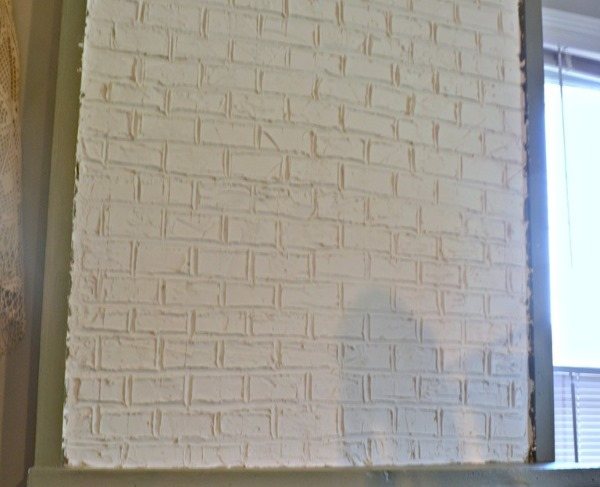

For this you need:
- stationery knife;
- foam sheets no more than 1.5 cm thick;
- pencil;
- adhesive for ceiling tiles;
- laser level.
If there are noticeable waves and pits on the surface, do not glue the brick. He will emphasize all the irregularities, they will become even more noticeable. For the convenience of cutting out bricks, you can make a template out of cardboard, which is then simply outlined on the foam, without making the markup every time. Usually the size of decorative bricks is 25x6 cm.
The first step is cutting the bricks. When the required amount has been cut, you can give the texture: cut off the chamfer from all sides, make the surface rough. A metal brush can come in handy here, it is pressed against the brick and furrows are made. You can also simulate pits and chips with a soldering iron.
Before gluing the brick, the walls must be treated as before painting. Old wallpaper is removed, the surface is washed and degreased. With the help of a laser level, markings are made on the wall so that the rows of bricks are even. You should start working from the lower right corner of the wall.


The seam between the bricks should not exceed 1 cm in width. When the wall is completely ready, the bricks need 24 hours to adhere to the wall more tightly. After that, they are painted with water-based paint.
Letters for wall or shelf decor
Styrofoam with a thickness of 1.5 cm or more is suitable. It is better to use equal sheets purchased specifically for crafts at a hardware store. Using a ruler and a felt-tip pen, the outlines of the letters are drawn on the foam. Then they are cut out with a clerical knife and all the irregularities are removed with sandpaper.
The basis for the letters is ready, its design is limited only by imagination. You can paint it with bright colors or stick rhinestones over the entire surface. These letters are decorated with artificial flowers. Purchased flowers are suitable, or rather the heads that were cut off, leaving a piece of the stem. They are stuck into the foam.
You can make corrugated paper flowers yourself.To make the letters glow in the dark, they glue the usual Christmas tree garland around the edges, or an LED strip.
Frames for pictures and photos
DIY foam crafts are made not only from smooth sheets and material from boxes. Styrofoam ceiling skirting boards are suitable for creating frames for photographs or paintings. They are already decorated with curly patterns or lines. This means that you don't have to invent anything new.


You only need to cut the plinth into 4 parts: 2 in width, 2 in height. Then carefully glue them together and fix them on the picture. You can decorate the walls with frames only, no photos.
Designers use this technique by creating contrast between the wall color and the frames. The filling of the frame can be not only a picture. The frame is glued to the wall, and several paper butterflies are placed inside, which are also attached to the wall.
Volumetric drawing on the wall
Flat shapes are cut out of polystyrene and painted in different colors. They decorate the walls in apartments, for example, for the kitchen, you can cut out several shapes in the form of cupcakes, buns, teapots and stick them on the wall above the table.
In the children's room, you can decorate the headboard of the bed from foam letters by composing the name of the baby, or cutting out his favorite cartoon characters.
Styrofoam paint
Since the well-known foam is initially produced in white, its painting is not something special or supernatural. Each of us has seen more than once the facades, finished with elements of foam or interior interiors with painted decorative details made of expanded polystyrene. Expanded polystyrene can be given any color you need, but for this you need to know what coloring composition is allowed to dye.


Styrofoam paint
Important! Styrofoam painting is possible with certain paints, but foam laminated tiles are not painted at all.
To choose a paint, you need to be sure that expanded polystyrene has the following properties:
- To begin with, the material must have high levels of water resistance.
- Have sufficient density
- They are not afraid of chemical influences and negative environmental influences
A good option for painting the material can be called water-based and acrylic mixtures. Let's look at the advantages and disadvantages of using these paints using a small table as an example:
| Water based paint | Acrylic | ||
| pros | Minuses | pros | Minuses |
| Odorless | The very word water-based means that the mixture is not able to withstand water, moreover, it quickly gets dirty | Resistant to water, dust and temperature extremes | Fragility |
| Good vapor permeability | Easy application and fast drying | High price | |
| The material is very easy to work with | No smell and wide color palette | ||
| Due to its low cost, it is available for everyone | High elasticity | ||
Characteristics of coloring compositions
The range of coloring agents is quite large. According to experts, it does not matter what kind of paint to paint the foam, if it is water-based. This is due to the fact that the type of polymer hardly reflects its properties. However, in order for the painting to be performed efficiently, you should know the advantages and disadvantages of the compositions used.
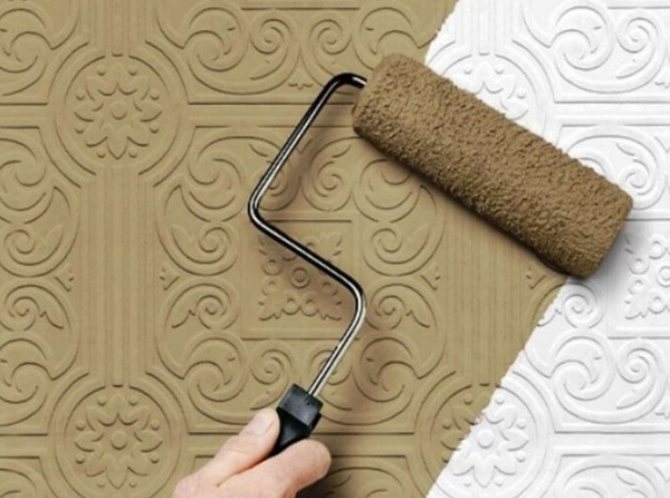

The best option for foam paint is acrylic
Among the dyes of the water-dispersed group, acrylic paint showed itself very well. This coating has the following positive properties:
- reliable protection against ultraviolet radiation;
- long service life;
- dries quickly and is odorless;
- health safety;
- ease of application;
- easy to clean if necessary;
- resistance to pollution;
- the composition is not affected by high temperature;
- a wide variety of shades.


The dyed foam is easy to clean
In addition to the listed advantages, such a coloring material has the only drawback - it is high cost. However, it is fully justified by significant advantages. A quality composition cannot be too cheap.
In addition to acrylic paints, you should pay attention to water-based coatings. They also have good properties.
Among the advantages:
- environmental friendliness;
- lies flat and odorless;
- good vapor permeability;
- large palette of colors;
- average cost.
The quality characteristics of this coating are inferior to acrylic composition. It has several significant disadvantages. The paint is not highly resistant to dirt and does not tolerate moisture well. Over time, its surface is washed off with water. If applied in large quantities, it can flake off. However, despite all these disadvantages, the water emulsion is quite in demand among consumers.
Methods to quickly paint the foam with your own hands
In recent years, foam products have begun to be used in all areas of human life. Most often they are used in construction, and not only as a heater. For example, decorative elements in the form of ceiling plinths and tiles made from this material are popular.
Since the foam is produced exclusively in white, many buyers think that it will not work for decorating their interior. Fortunately, there are ways to paint the styrofoam and give it a look that matches the overall decor of the room.
Painted foam is a great solution for decorating a room decor
The advantages of painted material
Polyfoam is a very popular material in construction, it is used for both external and internal work. However, after a while, it may lose its attractive appearance. In addition, the initially white decor may not match the color scheme of the room. These reasons force the craftsmen to paint the materials in a shade suitable for the interior.
In order not to damage the foam plate, you need to know which paint will not harm it.
Due to the fact that some compounds are capable of destroying the structure of expanded polystyrene, before starting work, it is important to figure out what paint to paint it with. Styrofoam will retain its attractive appearance for a long time if these works are done correctly.
In this state, it will have more advantages:
- it will be protected from moisture, dust, grease stains and other aggressive influences;
- the foam that has turned yellow over time will not become noticeable under the layer of the coloring composition;
- painting will facilitate daily care;
- the decor will harmoniously fit into the design of the premises.
How to paint a concrete floor with foam varnish - you will see in this video:
The material is very light and easy to use, so it is used by professionals and home craftsmen. It is widely used not only in interior decoration. Styrofoam elements often decorate the facades of buildings, garden and park areas, and insulate the facades of buildings with plates. With the use of dyes, you can embody many original ideas.
A correctly chosen coloring composition can keep designs and decorative items beautiful and attractive for a long time. In this form, they will be less sensitive to sunlight and other destructive factors.
Paint selection criteria
Foam products are sensitive to paints and varnishes. For this reason, you should carefully figure out how to paint polystyrene foam so that it retains its appearance for a long time.
Since this material does not tolerate acetone and other solvents, experts advise choosing water-based products. Such coatings are called water-borne.
They may be:
Since the foam does not tolerate solvents, the paint should be acrylic or water based
- water-based;
- acrylic.
Any type of paint must meet the basic requirements:
- it should fit well on the work surface;
- have high density and water resistance;
- be resistant to chemical attack.
All these parameters must correspond to the operating conditions of foam products.
However, not all Styrofoam items can be painted. The limitation applies, for example, to laminated plastic tiles for the ceiling. It only needs to be installed correctly, and it does not need painting.
Characteristics of coloring compositions
The range of coloring agents is quite large. According to experts, it does not matter what kind of paint to paint the foam, if it is water-based. This is due to the fact that the type of polymer hardly reflects its properties. However, in order for the painting to be performed efficiently, you should know the advantages and disadvantages of the compositions used.
The best option for foam paint is acrylic
Among the dyes of the water-dispersed group, acrylic paint showed itself very well. This coating has the following positive properties:
- reliable protection against ultraviolet radiation;
- long service life;
- dries quickly and is odorless;
- health safety;
- ease of application;
- easy to clean if necessary;
- resistance to pollution;
- the composition is not affected by high temperature;
- a wide variety of shades.
The dyed foam is easy to clean
In addition to the listed advantages, such a coloring material has the only drawback - it is high cost. However, it is fully justified by significant advantages. A quality composition cannot be too cheap.
In addition to acrylic paints, you should pay attention to water-based coatings. They also have good properties. Among the advantages:
- environmental friendliness;
- lies flat and odorless;
- good vapor permeability;
- large palette of colors;
- average cost.
The quality characteristics of this coating are inferior to acrylic composition. It has several significant disadvantages.
The paint is not highly resistant to dirt and does not tolerate moisture well. Over time, its surface is washed off with water. If applied in large quantities, it can flake off.
However, despite all these disadvantages, the water emulsion is quite in demand among consumers.
The advantages and disadvantages of coloring agents will help you decide which paint is best to paint the foam.
Indoor work
The process of dyeing foam products consists of several stages. Prepare the styrofoam before you paint it. To do this, use a primer.
An aerosol composition is best suited for this purpose, it is simple and easy to apply to the desired object, the surface dries quickly and can be ready for subsequent work in a short time.
This product is ideal for priming the desired element indoors.
Before you start painting parts, you need to prime them with an aerosol composition.
At the very beginning of work, it is necessary to clean the surface with a damp cloth and wait until it is completely dry. When using an aerosol primer, it is recommended to shake the bottle for a few minutes before application and then cover the material with it.
The composition is sprayed quickly, applying in a thin layer at a distance of 20 cm from the product. 3-5 coats of primer are enough to get a high-quality coating. After that, the material should dry completely. This takes about 30-30 minutes. Various irregularities or streaks can be removed with a spatula, slightly touching the surface.
Sequence of actions during work
To paint the outside and inside, select the desired type of composition.After choosing, you can start painting the product with your own hands. The easiest way to do this is to use an aerosol product.
To paint the foam with your own hands, it is best to choose paint in spray cans
Before starting work, shake the can for 1-2 minutes and then evenly cover the surface from a distance of 30 cm in 2-3 layers. Each time it must dry out and only after that the next layer can be applied. This method is considered the easiest if you learn how to work with a balloon.
If the composition is used in a can, painting is done with a brush or roller. The required amount of water is added to the paint to achieve a suitable consistency. If multiple shades are used, mix well before coating to get an even color. If the elements are painted in different colors, then the brush must be rinsed well with water every time.
To consolidate the result obtained, you can use varnish. A special water-based varnish is often used in combination with acrylic paint to further protect the foam surface.
Additional painting guidelines
To avoid streaks on the foam, you need to drive the brush in one direction. The purchased coloring material must have a high adhesion coefficient. In this case, it will easily fit onto the material.
To paint polystyrene, you need to have two brushes, a wide and a thin one.
If the paint contains solvents dangerous for expanded polystyrene, then a layer of plaster should be applied to the surface to be treated. It will serve as protection against destruction.
For better painting, it is better to have two brushes: a flat 4-5 cm wide and a thin round one for processing small details.
When working outdoors, do not use paints if the temperature drops below + 15 ° C. The quality of the coating will be negatively affected by high humidity. It is advisable to use only waterproof material.
Acrylic paint cannot be used at low temperatures and high humidity
Acrylics tend to bubble when applied in thick layers. Over time, it will begin to fall off. Experts recommend using paints that are completely ready for painting. They will facilitate the work of those who do not have the necessary experience in this matter and will help to get a high-quality result.
The process of dyeing polystyrene has many subtleties and pitfalls. However, following these tips, a home craftsman will be able to paint efficiently and quickly.
Source: https://kaminguru.com/materialy/pokrasit-penoplast.html
Preparatory procedures
At the very beginning, you need to get rid of the old layer of paint, wallpaper and putty. If the old layer has excellent adhesion to the surface, then it does not need to be removed. Next, level the surface, you can do this with a putty. Cover all bumps and depressions. This must be done, since if you install the penoplex, then over time they will break. The maximum error is one and a half centimeters per linear meter.
It is necessary to prime the unplastered surface. Metal structures that will be covered with a heat insulator must be painted. It is possible to cover with an anti-corrosion mixture. Before starting the procedures, it is necessary to hammer the brackets for fastening the drainage system, air conditioners, distribution boxes, and so on. Plates of insulation material are rolled using a needle roller.
Crafts for giving
We all know that to decorate your summer cottage, you need to spend a lot of money, but making something cute out of foam is a cheap pleasure. By winter, you can decorate the site with small and large snowmen. Take a wire and put three foam balls of different sizes on it and make him a funny face.


You can come up with a whole compositional picture for landscape design. Think over every detail, draw a sketch, prepare the material and get to work. You can create absolutely any shape: a flamingo, a swan, a penguin and many other ideas. If there is fantasy, then there will be beauty.
DIY crafts for boys - cool product ideas, photo examples, tips
DIY crafts in the kindergarten - advice on choosing materials, photo ideas for autumn, winter, spring products


Outside painting
To paint the styrofoam outside, you need weather-resistant paints.
The walls of the building are affected by temperature fluctuations, precipitation, therefore, the paint for expanded polystyrene should be plastic and not lose its qualities for a long time.
Before proceeding with staining, it is necessary to complete the preparation. For outdoor use, acrylic compounds are more suitable, since they are highly resistant to environmental factors.
Before painting, it is necessary to putty the joints. Then experts recommend applying a primer, after it dries, remove any irregularities. The paint is thoroughly mixed, brought to a uniform state and color.
You can apply paint with a brush or roller in one direction. Use an aerosol if necessary.
Painting extruded polystyrene foam on a building facade consists of several preparatory steps:
- the surface is leveled (including the location of the dowels), the joints are made invisible;
- cleaned of dirt and dust (for better adhesion of the primer);
- primed with an acrylic compound, the resulting drips are removed with a spatula.
After giving the paint the required shade, it is poured into a bath. To apply a decorative coating to the walls, a roller is used, moving it in one direction (from bottom to top) to prevent the formation of streaks.
After waiting for one layer to dry, apply the second. Often, during facade decoration, a layer of plaster is applied to the foam. Before starting treatment, facade paints must be mixed well.
If the ambient temperature is below 15 ° C, it is recommended to use waterproof materials, as the quality of the coating deteriorates with an increase in the humidity level. Bubbles may occur if acrylic is applied in thick layers.
Why paint styrofoam
Products based on foam are used for both interior and exterior decoration and insulation. It is used for heat and sound insulation of interior ceilings, partitions and walls, and in addition, many details for decorating the interior of premises are made from it. Often in the process of finishing work, it becomes necessary to paint the foam for one reason or another.
First of all, you need to think, why bother to paint expanded polystyrene? This operation is performed in two cases:
- Firstly, to create the effect of visual completeness and a holistic, harmonious interior, which consists in a combination of finishing elements, both among themselves and with the style of the room. There are hardly any connoisseurs of an interior in which white material with a bubble texture would be present as a decor. Most, as a last resort, will prefer a different type of finishing material, which would more harmoniously fit into the finish, please the eye and blend in with the environment. But foam has too significant advantages over other finishing materials, especially in terms of price and ease of installation, which, as a rule, is more rational to cover it with a paint and varnish coating than to look for a replacement in the form of another material.
- Secondly, a significant reason for painting, undoubtedly, is the need to protect it from the destructive effects of an aggressive environment.For example, from the effects of bad weather in the form of precipitation, temperature changes, storm winds and, ultimately, banal physical deformation of the material. All these factors seriously reduce the lifespan of foam products. As a rule, an unprotected foam covering very quickly, literally in one season, loses its original appearance.
Thus, the application of paint and varnish coating on polystyrene material can be considered a logical continuation of the work on finishing and decoration.
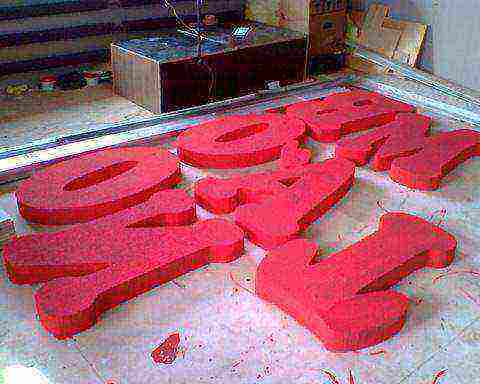

What to paint
Construction foam is deservedly considered one of the most versatile materials. It is used both for insulation and for cladding and as a material for the manufacture of most decorative elements.
At the same time, due to its low cost, products made from it have an affordable price:
- Ceiling tiles based on expanded polystyrene are an excellent choice as a finishing material for the ceiling, providing its aesthetic appearance, and does not require serious investments. It is not afraid of water, so it can be mounted in rooms with high humidity, such as a kitchen or bathroom, but the unprotected foam itself is very fragile, it is easy to damage it even accidentally with your bare hands. In addition, under the influence of direct sunlight, such tiles will surely fade and acquire a yellowish tint.
- Also, foam panels are one of the most popular and common options for organizing thermal insulation of walls of residential buildings. As a rule, they are sheathed with the outer parts of the house, its facade, which, unlike the rooms inside the building, is constantly exposed to the negative influence of nature in the form of frost, ultraviolet radiation, and precipitation. Therefore, such a coating, which has a relatively fragile structure, requires not only careful handling during installation, but protection in the form of a paint and varnish coating for the period of operation.
- Today, skirting boards are often used for interior decoration of a room, for the ceiling made on the basis of foam. When purchased, the color of such a decorative element is usually white. But often it is not the most suitable for a particular interior, and almost always uncoated material is not very practical. Therefore, in some cases there is a need to change its shade to something other than white. In addition, sometimes the surface of such a skirting board has defects that can be especially visible after installation, when the light in the room is on. In this case, painting is the only alternative to reworking all finishing work and replacing the skirting board. It will also not only mask flaws, but also add strength to decorative elements. One of the features of the skirting board, which is conducive to painting it, is that during its installation, joints are formed between its different parts, which have to be primed with putty, and in order to hide all traces at the final stage, the skirting board is covered with paint along the entire perimeter. Sometimes the need for painting arises suddenly, some time after installation, for example, after a roof leak, when stains appear on the white decor that cannot be cleaned. Then either buy and replace decorative elements, or paint everything and forget.
Paint requirements
Despite the huge variety of types of polystyrene-based foam, there is a problem of its compatibility with paints and varnishes. The fact is that this material is susceptible to the negative effects of organic solvents, just those that are part of most paints and varnishes. Thus, in order to cover a foam product with paint and give its surface a beautiful structure, without harming the material itself, it is necessary to know the features of its compatibility with different coloring compositions.
Expanded polystyrene is resistant to the effects of most substances, it can be applied to mixtures of bitumen, lime solutions on water, and also to be painted with compositions that have a water-dispersion basis. But the compositions belonging to the class of organic solvents, for example, ethyl acetate, toluene or acetone known to all, present in many types of paints, cause a change in the properties of this material, lead to its softening, shrinkage and ultimately dissolve altogether.
Therefore paints and varnishes for polystyrene-based materials must meet the following general requirements:
- the absence of substances in their composition that can dissolve foam plastics;
- increased coefficient of adhesion to penoplex and PSB;
- stability under the influence of destructive atmospheric factors, insolation;
- providing an aesthetic elastic coating.
Styrofoam painting
In most cases, paints based on an aqueous emulsion and acrylic suspension are used for painting foam. The choice of this or that type of paint depends on the location of the foam materials: inside the building or outside.
Inside the building
Inside the building, water-based paints and varnishes are almost always used. They are distinguished by their low cost, about 25-40 rubles per liter, but they are unable to withstand moisture and strong dust, which determined their specific use only for indoor premises.
When such paint is applied to the interior elements of the room decor, the optimal viscosity of the paint is ensured, which makes it possible to hide the pores in the material under a uniform coating layer. Before painting the ceiling tiles, moldings, baseboards and the decor of the rosettes, it is recommended to wipe them from cobwebs and dust with a dry cloth.
The joints of elements and technological seams are putty or sealed with special compounds. To ensure a high-quality, uniform coating with a rich color on a foam plinth, it is recommended to paint it in several layers, without fail starting to apply the next layer only after the previous one has completely dried.
Painting is usually done with a brush and roller. However, in the case of painting decorative elements with a fine and intricate relief, not a brush is used, but a spray gun, which allows you to quickly apply a uniform layer of coloring pigment to the material. To avoid paint splashing on the wallpaper, it is best to paint the baguettes and polystyrene curtain rods prior to installation.
Outside the building
Outside, acrylic-based solutions are used, which are highly resistant to the influence of an aggressive environment from the outside, but at a price they are much more expensive - from 50 to 50 rubles and do not differ in durability. That is, they need to be updated from time to time.
The characteristics of increased elasticity, resistance to atmospheric precipitation and contrasting temperature changes are very important for the use of paints as a coating of expanded polystyrene plates, which provide thermal insulation of the external walls of the house.
Modern paints and varnishes provide a wide choice for organizing outdoor work, but, unfortunately, almost all of them contain aggressive components that corrode polystyrene foam products. Therefore, before normal painting, the foam material is covered with an additional protective layer of sodium or potassium silicate solution, which is called liquid glass in a professional environment.
Previously, such a composition is diluted with water or a primer, due to which it acquires increased elasticity. Thorough mixing is required until a homogeneous consistency without lumps.
Another option for a protective coating for polystyrene materials is a thin layer of putty, after drying, with which it can be painted with any paint containing acid.
Tips / Recommendations
- To prevent the appearance of streaks and streaks on the foam, you should always brush in one direction.
- If the skirting boards are already installed on the wall decorated with wallpaper, it is recommended to use masking tape to protect them.
- In the event that it is not possible to use paint that does not contain solvents and gasoline for painting the foam, you can always use a layer of ordinary plaster to protect it. Thus, corrosive chemicals will be isolated from the material.
Recently, home craftsmen have mastered the technology of making all kinds of decorative elements, ornaments and volumetric letters from expanded polystyrene. But not everyone knows how and with what to paint foam for crafts. I want to share my experience and tell you about all the important nuances of this operation.
Styrofoam painting requires a competent approach
Special properties
- If the question arises, which foam for crafts is better to choose, then the answer is simple - any. You can purchase it separately in the store, or use the one sold with the item in the boxes.
- Counterfeits are not subject to excessive moisture. They can be used both in winter and in summer and not be afraid that they will lose their attractive appearance. Even frosty days are not at all scary to them.
- Even if the material deteriorates slightly over time, it can be easily reanimated and restored to its original state. It doesn't take a lot of strength and energy.
- If you need to ensure that the fake is firmly in place, then you will need to make a strong stand of heavy weight.
- There is no need to use expensive materials to process the material.
- This material has one significant drawback, it is afraid of fire. If you use paints that use acetone, then the material will simply deteriorate. Therefore, you need to take this fact into account when decorating.
Styrofoam crafts for kindergarten
DIY foam crafts are made with children for creative contests in kindergarten.
Fishes
To make fish you will need:
- cardboard;
- stationery knife;
- glue;
- scissors;
- gouache and brushes;
- eyes for toys.


DIY styrofoam crafts for home or kindergarten.
The contour of the future fish is cut out of cardboard. From thin foam (ceiling tiles are suitable), small circles are cut. They will play the role of scales. Fins and head are cut separately. The blanks are glued to cardboard and painted with gouache. At the end, eyes are glued.
Small house
For the house you need:
- smooth foam;
- glue or toothpicks for holding parts together;
- paints;
- knife;
- pencil;
- ruler;
- cardboard.
With the help of a ruler, two side walls of the house are drawn on the foam. Then the front and back walls. For convenience, you can draw walls with an angle, where the roof will then be attached. For the roof you need 2 rectangles. When all the details are cut, small details are worked out. Tile-shaped grooves can be extruded on the roof.
For this, a knitting needle or the opposite end of a brush is suitable. Windows and doors are cut on the walls. The walls are glued together, you can use toothpicks if the thickness of the foam allows. They need to be stuck into the ends of the side walls up to half, and then carefully connected to the side ones. The structure is glued to the cardboard.
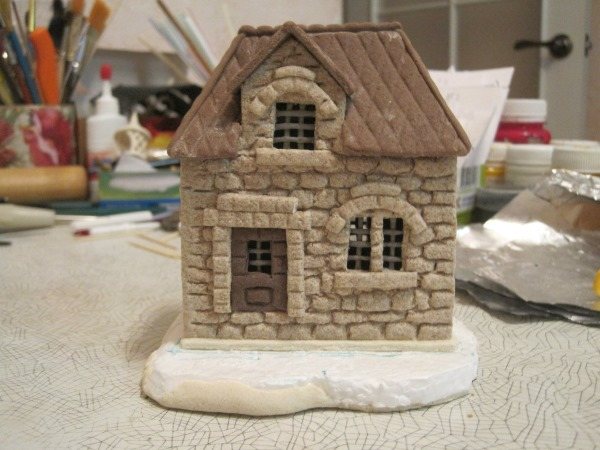

The bottom is decorated with cotton wool or moss. Shutters are cut out of the scraps, carefully glued to the sides of the windows. When the house is fully assembled, it is painted with bright colors.
Snow Queen's Castle
To assemble the lock, you need to cut identical cubes from foam plastic, about 2x2 cm. Cardboard is used for the base. On cardboard, you need to draw the markup: a fence, towers and other details. The towers are assembled in a circle, the foam cubes are glued to the cardboard at the same distance. The gap should be at least 1 cm. The second row is set out of the "bricks", placing them not on top of each other, but shifting them.
So it is laid out row by row until the tower reaches 7-10 cm in height.Separately, in the same way, the upper part of the towers is assembled. It should be narrower than the bottom, so the rows are reduced by 1 cube
The upper part is carefully glued to the lower one. For the roof, they take blue cardboard and make a cone out of it.
Gently glued to the foam building.
By analogy, a fence is assembled. It is not necessary to make it an even square; round "pillars" can be laid out in the corners. The inner courtyard is decorated with old cut DVDs and deer figurines, which are also carved out of foam.
How can you paint your styrofoam products?
The choice of paintwork materials directly depends on the specific conditions in which an object made of foamed plastic mass is used: on the street or indoors. So, painting a ceiling tile made of foam plastic should be carried out with one type of paint, the facade of a house or letters on a sign - with another, a ball that performs the function of a float and operated in the water during fishing - with a third.
Acrylic-based paints have a lot of advantages:
- do not corrode the painted surface;
- resistant to external aggressive factors (rain, dust, dirt, snow, ultraviolet rays);
- do not have a pungent odor;
- dry quickly;
- safe;
- easy to use;
- form a washable coating;
- resistant to sudden changes in temperature;
- have a wide range of shades.
Their only drawback is the high price, but it is justified by the above-mentioned advantages of this type of paintwork materials. If it is not possible to purchase such a paint, you can use any coloring composition, but before painting, to prevent corrosion of expanded polystyrene objects, it is necessary to cover the surfaces with liquid glass - a solution of sodium or potassium silicate. Previously, this tool is diluted with water or a primer to increase its elasticity.
Choosing paint for indoor foam (ceiling tiles, baguette, children's crafts)
How to paint ceiling tiles, baseboards, baguettes and children's crafts from this material at home? For indoor work, water-based paintwork materials are usually used, which are famous for the following advantages:
- environmental friendliness and, accordingly, safety;
- ease of application;
- lack of a pungent odor;
- excellent vapor permeability;
- a wide range of shades;
- availability;
- optimal viscosity, allowing to mask small defects and pores of the foamed plastic mass.
The qualitative characteristics of water-based compositions are somewhat inferior to acrylic ones. The water emulsion has significant disadvantages:
- low resistance to dirt and moisture - during operation, the coating is washed off, and you have to process the surface again;
- predisposition to peeling - in fairness, it should be noted that this type of paintwork is peeled off only when it is applied with a too thick layer.
Despite the listed disadvantages, this paint still occupies a leading position in the list of demanded types of paintwork materials. For painting decorative items made of foamed plastic (ceiling tiles or baseboards) this is one of the best options. As for small items made of polystyrene, for example, crafts made by a child, it is best to paint them with gouache.
Choosing a paint for foam, if the product is operated in water (fishing float)
Polystyrene balls, which act as bait for fish, some fishermen prefer to paint. The need for this manipulation is a highly controversial issue. Many fishing enthusiasts find painting a foam float a waste of time. To paint this item or not, each fisherman decides for himself, taking into account his experience.
You can paint the ball:
- permanent marker;
- waterproof felt-tip pen;
- polymer or polyurethane paint from an aerosol can.
Self-painting a foam float will cost a little more than buying a finished product if you buy paint. Painting on your own requires a certain amount of time and effort. For this reason, most fishing enthusiasts take on such work in order to build a product in its own special shape and size, as well as in the presence of paint.
To make the float more attractive to the inhabitants of water bodies, it is recommended to resort to aromatization. To do this, it should be treated with a special aerosol or soaked for a while in water with the addition of vanillin, garlic juice, chopped dill or parsley. These fragrant balls guarantee a great catch.
Sequence of actions during work
To paint the outside and inside, select the desired type of composition. After choosing, you can start painting the product with your own hands. The easiest way to do this is to use an aerosol product.


To paint the foam with your own hands, it is best to choose paint in spray cans
Before starting work, shake the can for 1-2 minutes and then evenly cover the surface from a distance of 30 cm in 2-3 layers. Each time it must dry out and only after that the next layer can be applied. This method is considered the easiest if you learn how to work with a balloon.
If the composition is used in a can, painting is done with a brush or roller. The required amount of water is added to the paint to achieve a suitable consistency. If multiple shades are used, mix well before coating to get an even color. If the elements are painted in different colors, then the brush must be rinsed well with water every time.
To consolidate the result obtained, you can use varnish. A special water-based varnish is often used in combination with acrylic paint to further protect the foam surface.
The principle of staining the material
If you want to paint a molding or baseboard, you can use water-based paint. When choosing water-based paints and varnishes, I give preference to all the familiar Tikurilla, because only high-quality mixtures can truly transform the painted surface. So:
- We clean the surface for painting - remove dirt and dust with a dry cloth
- Use a brush and brush in one direction - this way, you will not have streaks.
- If you are looking for a rich color, you can apply multiple coats of paint to the foam. But in this case, wait for the complete drying of the previous layer.
- If a foam tile is painted, which has a relief shape, then a roller or brushes will not help here. In this case, it is advisable to use a spray gun - it is thanks to spraying paintwork materials that it will be possible to achieve uniform application of a non-expanded polystyrene product

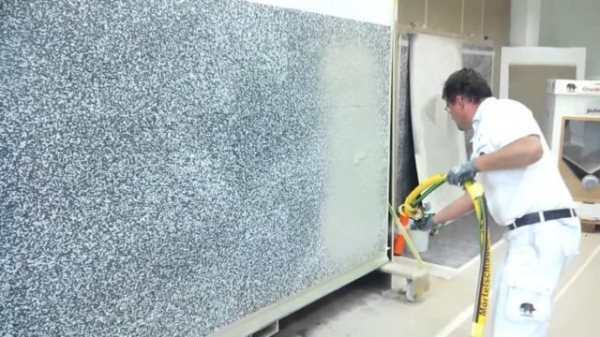
How to paint the styrofoam?If you need to paint the styrofoam outside your home, you can use acrylic paint. But to protect the material from the chemical composition, first we will apply a protective layer. Most often, putty is used in the role of protection. I used liquid glass, and this is how it happened:
Diluted "liquid glass" with a primer to a homogeneous mixture. If the composition does not collect in droplets, then you can be sure that it forms a high-quality coating on the foam and closes all the pores of the material
- After the surface has dried, it is allowed to paint it with acid-based paintwork
- Most often, the facade finishing of foam plastic is to cover it with plaster. Choose facade paints and mix them thoroughly before applying to walls
Painting buildings outside
Acrylic-based compounds can be painted on polystyrene when carrying out interior and exterior decoration of the room. Painting work on external insulation requires more careful preparation of the foam surface.Before painting the styrofoam or styrofoam with acrylic paint:
- clean the surface from dust, adhesive residues, dirt;
- glue the reinforcing tape to the joints;
- level the surface of the product;
- prime with acrylic compound;
- peel off the paint;
- prepare the necessary tools.
Apply paint to the foam layer from top to bottom in one direction to avoid color unevenness. Apply the second layer after the first one is completely dry.
How can you paint the styrofoam on the street? Use rollers, brushes, spray gun for painting. Protect the skin, respiratory system and eyes from splashes of paint when using a puller.
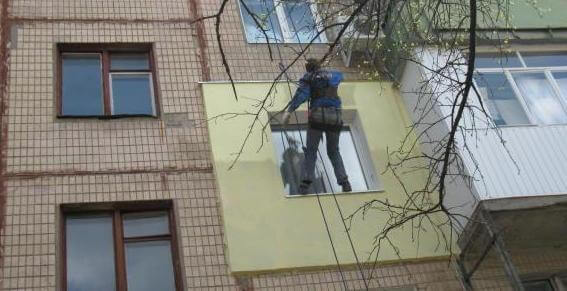

The coloring of the penoplex is no different in terms of the technology, the compositions used, the tool used from the coloring of the expanded polystyrene foam.
The application of a covering layer of putty, plaster, liquid glass to the surface of the thermal insulator significantly expands the scope of application of paints and varnishes. The created intermediate layer neutralizes the destructive effect of active coloring compositions on the foam. The protective layer is applied to the fiberglass mesh. This leads to an increase in the cost and duration of work, but ensures the presence of a protective "shell" of insulation, ready for painting with any formulations.
The use of acrylic paints will reduce the time and cost of work to protect the foam insulation from premature destruction.
We spent less money, and the house stays warm longer!
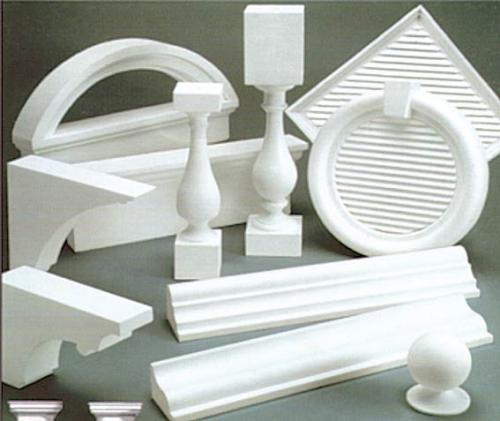

- How to paint styrofoam
- How to decorate a garden, vegetable garden
- How to make volumetric letters from polystyrene with your own hands
1. Try to prevent drafts in the room until the paint is completely dry on the surface.
2. Remember that gouache is a water-borne paint. Therefore, in case of contamination, wipe the painted surface only with a dry cloth.
Foam wall cladding is in great demand for both external and internal cladding. If for outdoor work, foam plates are used as insulation, then for the interior inside the house there are elements of various shapes. These can be baguettes, skirting boards, frames and other decorative details. But for any finished design with such a design, painting the foam parts is necessary. So today I will tell you how to paint polystyrene and what is the do-it-yourself painting technology.
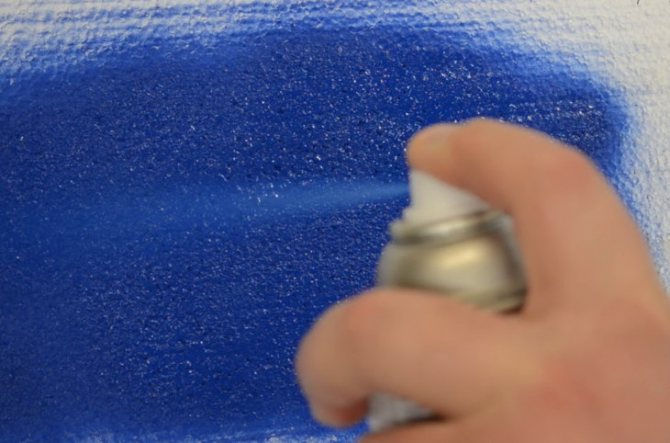

"Physical" selection
What paint to paint the foam. When choosing a paint, in addition to a "soft" attitude to the insulation, it is necessary to pay attention to:
- adhere well to its surface;
- withstand the damaging effects of light, wind, moisture (waterproof) (important for outdoor decoration);
- create a durable elastic coating.
It should also be borne in mind that the drying oil contained in the oil paints will not harm the heat insulator. But the paint layer formed by it is very static. With the temperature movement of plates, shrinkage of building structures, mechanical stress, the appearance of chips, cracks, delamination is not excluded.
Styrofoam coloring
The fact is that all foam panels and skirting boards are produced only in white, which in itself is not bad, but sometimes the white color does not correspond to the general decor of the room, and then it becomes necessary to paint them. This is where unforeseen difficulties are found - sometimes, after applying paint, the foam begins to dissolve literally before our eyes. Not all craftsmen know how to paint polystyrene without damaging its structure.
How to paint styrofoam
The chemical formula of the foam is such that it dissolves easily under the influence of white spirit, acetone and some other aggressive chemicals. Therefore, for painting foam, you cannot use products containing the above ingredients in their composition.Styrofoam can only be painted with water-based paints:
- acrylic water-based;
- acrylic water-dispersion;
- acrylic latex-based paints.
Many manufacturers make acrylic paints in white only, but they are given the desired tone using separately sold special colors. By gradually adding such a color to the white paint, you can achieve the desired color intensity, and by mixing several colors, you can get the desired shade of paint. In large stores selling building materials, experts will help you do this right at the time of buying paint.
How to paint foam panels
- You need to paint the panels already glued to the ceiling. The seams between the panels must be putty and cleaned with fine emery cloth. Brush off the dust from the panels with a soft brush and wipe them off with a cloth. If possible and desired, the panels can be coated with a special primer before painting.
- If necessary, dilute the paint with water to the desired consistency. Check the tone of the paint and its thickness - use a brush to apply paint to a piece of styrofoam and watch how it lays down.
- Paint the ceiling with a paint roller, moving it in one direction. Unpainted areas that may form along the walls, paint over with a wide flat natural bristle brush. Acrylic paint dries pretty quickly. After the first coat of paint has dried, another coat can be applied to it.
- If the ceiling tiles have a complex embossed pattern, use a paint spray gun to paint them not with a roller. This way you will be able to evenly paint all panels in both convex and recessed areas of their relief.
How to paint a Styrofoam skirting board
- To obtain the best result, you need to paint the skirting board already glued to the ceiling - in this case, the paint will mask all the joints.
- Putty the joints and sand the seams. To protect the walls and ceiling, stick masking tape along the skirting board, close to it.
- Paint the skirting longitudinally with a narrow, flat brush with natural bristles. When the paint dries, paint over the plinth again, and after the second coat of paint has completely dried, remove the masking tape from the walls and ceiling.
About how and with what compounds you can glue the foam, it is described in our article How to glue the foam.
How to paint foam products: methods and tips
Nowadays, when decorating premises, such a convenient, lightweight and inexpensive material as polystyrene is often used.
Cornices, various elements, baguettes, picture frames, skirting boards, segments of ceiling tiles, various decorative details, for example, large interior letters, are made from it.
Since the natural color of the foam is white, it is often necessary to dye it. In the article, we will tell you how to paint polystyrene yourself at home.
Quality requirements
Polyfoam is a wonderful material that is widely used for construction and decoration of buildings. Also elements: foam letters, tile details, cornices are used in interior decoration.
It is an inexpensive and practical material, lightweight and easy to process. Often, ceiling tiles are made of foam, which, after installation, are able to please the eye and serve flawlessly for a long time.
Styrofoam finishing gives the room a neat and aesthetic appearance in a short time. Moreover, such finishing is inexpensive, and the work can be carried out independently: to paint the ceiling plinth made of foam, you do not need to invite a hired specialist finisher.
What characteristics should the foam meet so that you can paint it without fear.
Foam plinths, tile elements, letters, cornice or baguette must be made of a material with a high degree of moisture resistance. Otherwise, the foam will not be able to withstand staining.
The best choice for painting is dense foam, which is not so easy to break. Loose, porous material is not suitable for this purpose.
The foam must be resistant to chemicals, and also not be too afraid of mechanical damage. Sometimes, to paint a baseboard or ceiling, you need to use paint containing aggressive components. It is necessary that the material withstands.
Choice of paint
What coloring composition to stop at - consider this important issue.
An excellent solution for processing foam parts would be the choice of water-based or acrylic paint. They are odorless, durable, excellent "behave" in operation, have a large and beautiful palette of shades. Let's take a closer look at their advantages and disadvantages.
Water-based paint
It has no smell, which means it can be used indoors even in winter with closed windows. The coloring water-based composition has excellent vapor permeability, which means that the foam plinth or border will not interfere with the normal moisture exchange in the room. The paint is elementary easy to work with and has an inexpensive cost.
As for the shortcomings, in order to process the foam with this paint, the latter must be very waterproof and dense. Otherwise, it will not withstand the effects of the water-based composition, but if you are wondering how to paint the ceiling plinth, water-based paint is fine.
Acrylic
This option is convenient because acrylic paint can be used under any external conditions - even in a dusty, humid or cold room. Acrylic paint is not afraid of such conditions, retaining all its technical and decorative characteristics. It can be used to cover both ceiling tile segments and elegant decorative moldings.
The paint is easy to use, it has no smell, it has a huge range of shades. It is also possible to create your own colors with the help of color schemes, achieving the desired result.
The disadvantages of acrylic coloring composition include a rather expensive price, not too high resistance and durability.
Tips
If you want to paint decorative small foam knickknacks, then ordinary art gouache and the same brushes from the stationery store are best for this purpose.
In order to paint skirting boards or cornices, it is better to use water-based paint. But for outdoor work with foam, acrylic compounds are better suited.
What is the difficulty in dyeing foam?
Before trying to paint a foam product with your own hands, you need to find out what features the material from which it is made differs, and how it reacts to certain paints and varnishes. The foam has a porous structure and extremely low density. Simply put, it is very fragile
For this reason, it is necessary to paint products from it carefully so that they do not crumble or break.
As for the choice of paints and varnishes (LKM), you need to be careful here. It is necessary that the paint components do not damage (corrode) the surface of the foam object.
Styrofoam painting
We figured out how to paint polystyrene, now we will consider how to do it correctly. So, this procedure can be roughly divided into two stages:
Painting stages
Preparing the foam surface
Before painting the foam, the surface must be primed. This operation is performed in the following sequence:
| Illustrations | Description of actions |
| Materials. You will need a multipurpose acrylic primer to prepare the foam for painting. |
Padding:
|
According to the scheme described above, only ordinary polystyrene foam is prepared for painting. If you are dealing with extruded polystyrene foam or even laminated foam tiles, the surface must first be sanded to roughen it. After that, the sanded areas should be covered with a special adhesive primer (primer).


Extruded polystyrene foam must be treated with an adhesive primer before painting
Related article: Correct disconnection of heating batteries
Painting
The process of painting the foam is as follows:
| Illustrations | Description of actions |
Preparing paint:
| |
Paint application:
|


In the photo - the procedure for painting the ceiling foam plinth under malachite using glaze
When working with glaze, painting is carried out in a slightly different way. As a rule, glaze is applied using a spray gun, after which the surface is rubbed with a brush or sponge, giving it a certain texture. Glaze of different tones can even be applied in two or three layers.
To highlight relief patterns in a certain color or gilding, use an ordinary thin art brush.
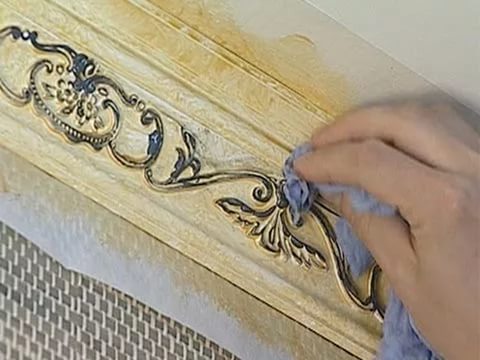

Glazes can be used to highlight the embossed pattern of foam decorative elements
With liquid glass, things are a little different.


The main solvent in this material is simple water, which, as the liquid glass hardens, simply evaporates or enters into a chemical reaction. In terms of composition and properties, liquid glass is very close to silicate glue, which was very popular at the end of the last century.
The composition of liquid glass does not contain as many aggressive components as acetone or kerosene, so it does not destroy the structure of the foam. And the chemical processes taking place in the layer of hardening liquid glass are also practically harmless to the penoplex. And the dried silicate becomes practically chemically inert.
Modern experience in the use of liquid glass shows that it can be successfully used for processing foam. This silicate composition can be added both to the composition of cement mortars for plastering, and applied directly to the surface of the foam, depending on the goals and objectives. At the same time, the surface acquires good protective properties from both moisture and many chemicals.
How to paint polystyrene - staining technology
Foam products are used today in decoration
interior more and more.
This is due to the prevalence of these decorative elements, with the affordability of prices for them, with the creation of a unique interior, as well as with fashionable trends in interior decoration.
Although it is an inexpensive material, it has its drawbacks, it is produced only in white.
Before painting the styrofoam, you need to purchase certain types of paints, as some can harm decorative elements.
When and what not to paint
Some types of polystyrene decor products cannot be painted at all, for example, in the case of laminated ceiling tiles.
Also, do not paint foam surfaces with paints containing acetone and alcohol, they can corrode the surface.


It should not be painted when wet or if it regularly gets wet.
It can worsen the bond between the material and the paint, which will not last long in this case. Also, do not paint when there is dirt and dust on the polystyrene.
How to choose the right paint
The choice of a particular paint mainly depends on where the foam product is located, as well as what functional load it will carry.
It is necessary to take into account the properties of each species, for example, resistance to moisture, or harmlessness to the human body.


One should look to buying time-tested brands that can offer good quality products.
We process polystyrene inside the building
In order to paint parts that are inside a building, for example, skirting boards, water-based paints, the so-called water-based paints, are very suitable.
It has a number of advantages:
- Perfectly clogs the pores of foam products;
- It is easy to apply to the surface;
- The cost is quite low;
- Safe for people and animals;
- Has no pungent odor.
Apart from the pros, there are also several disadvantages. Unfortunately, it does not tolerate exposure to water and is quickly washed out.
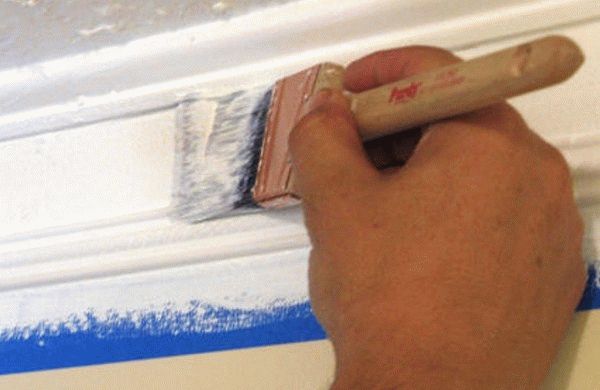

She also "does not like" the impact of dust on her, from the impact of which her appearance deteriorates.
Acrylic paint has similar properties, however, in addition to the advantages listed above, it is resistant to dust and dirt, but costs a little more.
The best today are silicone mixtures, they do not have serious drawbacks, but they are quite expensive.
Recommended for viewing:
Also inside, the foam can be decorated with drawings of gouache and watercolors, if they are not exposed to the aggressive effects of the environment.
Painting of external parts
To paint the external parts of the interior, you must use completely different painting materials.
In order to determine how to paint the foam outside, you need to know what requirements the paints must meet:
- Resistance to the external environment, in the form of precipitation, wind;
- Resistance to temperature changes;
- Cost;
- Protection from physical impact;
- Long service life.
Usually, an acrylic suspension is used for painting external polystyrene products, which should not contain freon aerosols.


This type of paint dries quickly and protects the surface of products, creating a protective film.
To expand the number of types of paint used, you can apply a special protective layer to the product before painting, which will protect it from the effects of destructive elements.
It usually consists of a mixture of "liquid glass" and a primer. After applying it to polystyrene and drying, you can safely paint these parts with paint containing acidic components.
You can also protect it by applying a continuous layer of putty to it.
The most basic tool for painting styrofoam is a brush. Brushes of different sizes and shapes can be used depending on the type of paint and its shape.
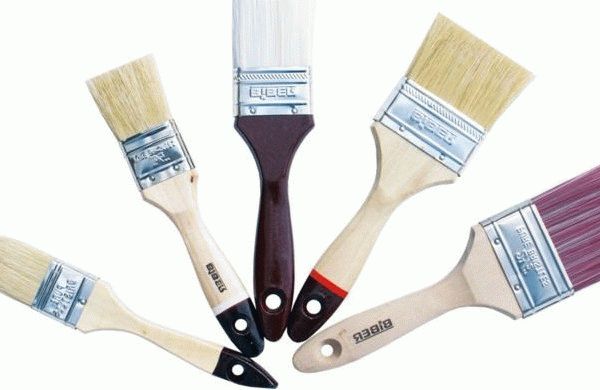

Wide varieties are used for flat and large surfaces, and thin brushes are needed for decorative elements with complex curves and patterns.
A round brush is ideal for painting concave skirting boards. In order for the layer of paint to lay down evenly from the brush, it is necessary to apply strokes in only one direction.
Multiple coats are desirable to obtain a uniform color.To paint complex parts, it is necessary to glue over parts that are not painted with masking tape so as not to get dirty.


A roller on a stick is perfect for painting flat walls, its use is convenient because it captures a large surface area, due to this, painting is much faster than with a brush, plus the paint lays down evenly.
It is possible to use a spray gun on the street, this method is also quite fast. However, when using it, certain skills are needed, otherwise smudges may form on the foam.
The color scheme, which is needed for mixing colors, will help to get the desired color; you can purchase it at any specialized hardware store.


For gouache and watercolors it is necessary to purchase special artistic brushes. You can buy them in art shops.
Before starting work related to painting, it is necessary to clean the painted surface of the foam.
This can be done with a dry cloth, in severe cases when it does not rub off, you can use sandpaper.
If several joined parts are painted, then it is necessary to grind the seams to obtain a smoother surface.
Benefits of work
Painted decorative elements will blend into the interior of the room much better than unpainted ones.
The desired color creates the effect of a complete image of a room, building, etc.
Every day there are more and more foam products on the building materials market, and this is due to the growing popularity of these products.
Fashion trends, price, and ease of installation and many more factors affect this. Polystyrene today helps to simplify complex design decisions.
Share this article with your friends on social media. networks!
When copying materials, an active link to the source is required.
Craft options for the site
For a vegetable garden or garden, you can make foam figures. They will decorate paths between beds, flower beds or a recreation area.
A bird on a tree
To decorate the trees on the site, you can make bird figures with your own hands. To do this, you need to draw a template on paper, and then transfer it to a sheet of styrofoam. For birds larger than 30 cm in length, thin material will not work. At a minimum, the thickness of the sheet should be 1.5 cm. A figure is cut out with a sharp clerical knife.
It can be a flat drawing or a three-dimensional figure, if the wings and tail are cut out separately. Now all the pieces are glued together. In order for the figure to decorate the tree as long as possible, the foam is primed in 3 layers. Each layer should dry well. After drying, start painting. Apply the usual facade paint, and then varnish.
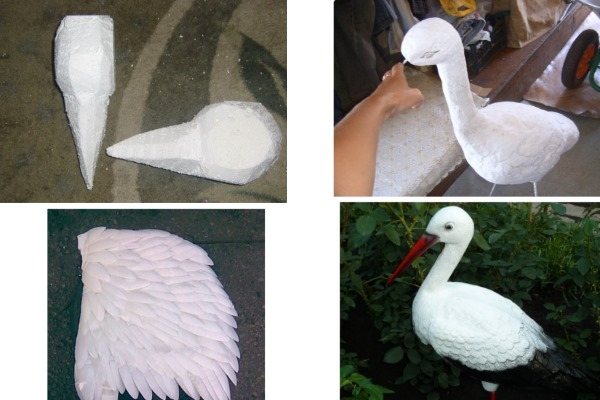

It will not wash off with rain and will not harm the material, because it is protected from impact by a thick layer of primer. The dried figurine is attached to the tree using wire or nails.
Frog
For the stencil, you can use the image of a cartoon character, for example, "The Frog-Traveler". Fine-grained, dense foam is suitable for work. The drawing is transferred to the material and carefully cut out with a clerical knife. All irregularities and burrs are removed with sandpaper. Now you need to prime the workpiece and paint.
After the paint has dried, a layer of clear varnish is applied. It is convenient to use varnish in cylinders. The main thing is that there are no untreated areas left. Thick wire is used to secure the frog to the ground. The figurine is carefully placed on one end, the other is stuck into the ground. If you want to place the craft on the stones, near the pond, cement will do.
Crocodile
Styrofoam may not be the only material for creating DIY crafts.


To make a large crocodile, you will need:
| Material | amount |
| Styrofoam | About 4 sheets 100x100 cm |
| Plastic bottles | 25-30 pcs. |
| Self-tapping screws | 100 pieces. |
| Cling film | 2 rolls |
| Scotch | 1 reel |
| Whatman | 1 PC. |
| Foam Adhesive | 1 bottle |
| Stationery knife | 1 PC. |
| Scissors Paint in cylinders White paint Screwdriver | 1 PC. 2 cylinders red and green 100 ml 1 PC. |


A silhouette of a crocodile is drawn on whatman paper. The base, the frame is made of foam. Suitable material is uneven, from under household appliances, with any density. The main thing is to cut out the torso with the head, tail and paws. All parts are held together with glue. Then the foam blank is shaped by grinding with a knife. It is necessary to mark well the eyes, nostrils and toes.
The workpiece is tightly covered with cling film and tape, if necessary. The film must cover the entire surface. This is done in order not to waste time on putty and to protect the foam from the effects of paint from the balloon. The base is ready, it remains to add small details.
To protect it from rubbing, the entire abdomen of the crocodile is closed with plastic from the bottles, which is attached to self-tapping screws. The upper part is covered with plastic scales. From the bottles you need to cut strips, about 5 cm wide, and cut into teeth. The strips are fastened with self-tapping screws, starting from the tip of the tail.
The crocodile's teeth are attached in the same way, with self-tapping screws. Below, on the abdomen, there should be a wire with which you can fix the figure on the ground. Plastic is also inserted inside the mouth.
For this, a 5 liter bottle is suitable, without a bottom and a neck, cut lengthwise. The eyes are decorated with plastic from the rounded parts of the bottles. After the scales have covered the entire body of the crocodile, you can paint it.
It is more convenient to apply paint from a balloon - there will be no smudges. The body is painted green, the open mouth red. The teeth are painted with white paint separately, with a brush. When the craft is dry, you can decorate the garden with it.
Materials that hold together
If a person is faced with the task of making a small, small figure for a school event, this is one case, but if it is necessary to make heavy and massive figures for wealthy home owners, this is a completely different case.
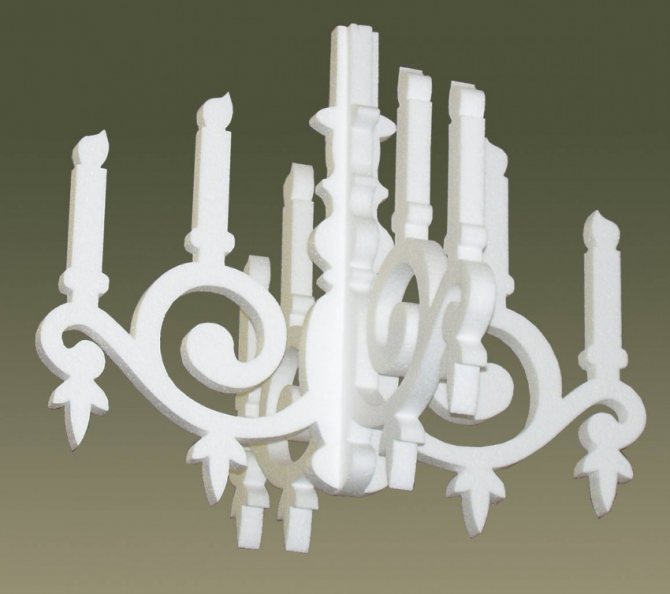

In this case, ordinary PVA glue cannot be dispensed with. Therefore, you should stock up on stronger adhesives in advance. This can include:
- sealant (preferably a silicone version);
- liquid Nails;
- special glue for gluing foam;
- facade glue (its main advantage is resistance to cold and frosty weather);
- foam for installation.


How to paint penoplex: choose suitable materials
"As the painter is, so is the color."
One friend recently insulated a room in his country house, where he intends to come in winter, and a loggia in an apartment with penoplex. It is also called polystyrene foam. Everything looks neat and beautiful.
However, the question arose, is it necessary to protect the insulation with paint? From here the topic of this article was "born" - how to paint penoplex. By the way, the blog already has information on how to fix such a heater.
Let's start with a brief description of the "fashionable" modern heat insulator. It is produced from hydrocarbons (oil, gas, coal). Penoplex is a kind of polystyrene that has gone through a deep evolution. And only for the better. Here are some points in which he differs from his "old relative":
- Flexural strength is 5-6 times higher:
- Moisture absorption is 6-8 times less. They can insulate attics and other "wet" areas;
- The strength of some types is ten times higher than that of polystyrene;
- Fire resistance. It is a self-extinguishing material, unlike smoldering foam;
- Better insulation and sound insulation properties;
- Convenient to work with. Easy to cut with a knife. Due to its fine-mesh structure, it does not crumble;
- Wide and varied assortment;
- Service life, about 50 years.
Things are good. Except for the price. If we are talking about the insulation of the balcony, then the amount of material is small, however, when the insulation of an individual house is required. you have to pay more.
Now about whether it is possible to paint penoplex? Can.Many modern manufacturers offer acrylic water-dispersion paints designed for coating thermal insulation and with excellent, stable adhesion. *
Adhesion * (in Latin - "sticking") - the ability to firmly adhere to the surface.
In this article, you will learn:
How to paint expanded polystyrene
Features of the choice of paint
Let's see how you can paint the foam. When choosing a paint, it is necessary to take into account the fact that polystyrene foam is not resistant to chemicals such as acetone, white spirit and other solvents that are often used in paints.
Therefore, the choice is limited only to water-based coatings, which are called water-dispersible. These formulations include the following types of paints:
In fact, it does not matter which type of water-based paint and varnish coating you choose, since the type of polymer practically does not reflect its properties. Therefore, when choosing a paint, it is necessary to pay attention to its characteristics such as:
- Application area. Water-dispersion paints are both universal, which can be used for indoor and outdoor work, and narrowly focused, that is, intended only for indoor work;
- Abrasion resistance. This property is important if a foam product will be exposed to mechanical stress;
- Moisture resistance. Important in cases where the surface will be exposed to moisture. For example, moisture-resistant paint will be needed for painting fillets or ceiling tiles in the kitchen, where the surface is wet cleaned;
- Durability. This indicator is rather arbitrary, since it depends on the operating conditions of the painted surface. However, it gives a rough idea of the quality of the paintwork material;
- Opacity. The lower this indicator, the more layers of paint will have to be applied in order to paint over the surface of the foam. Accordingly, the consumption of paint increases.
I must say that the hiding power of water-dispersion paints is usually lower than oil, alkyd and other similar coatings. Therefore, they are applied in several layers.
Manufacturers usually indicate all these characteristics on containers with paint.

